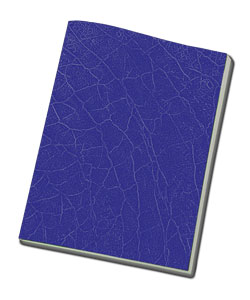Quick copy and small commercial printers frequently ask us about the best way to avoid wrinkling, sometimes called “alligator skin,” when folding cover stocks. Copiers and digital presses can print on some fairly heavy papers. The problem arises because the types of tabletop folding machines found in these smaller operations or in-plant departments are usually designed for text papers. The smaller the  fold roller diameter, the smaller the range of papers you can run. Curl also increases in severity as fold roller diameters decrease.
fold roller diameter, the smaller the range of papers you can run. Curl also increases in severity as fold roller diameters decrease.
I checked several folding machine manuals and found some limits to be around 180gsm, which is about 7-8 pt. or 80# cover. Other machines are limited to running paper only, up to around 60 or 70# offset, and others will run only 20# bond. Of course the average person is going to test those limits. I know I would. If the folder is sitting right there on the counter top and a customer is waiting for that freshly printed greeting card or invitation to be folded, who isn’t going to give it a shot?
The danger in forcing paper through that doesn’t fit within manufacturer’s specifications is that you will wear out the bearings and fold rollers prematurely. Then the machine isn’t any good even for the paper it’s supposed to run. There is also the danger of paper jams. Many low-cost folders are made of light plastic and a serious jam can break these plastic components.
So what can we do in such a situation? Here are a few things to try that might just get you through that difficult folding job.
Find a folding machine that is better equipped to handle heavy stocks. Use a machine with larger fold roller diameters. If you have one in the shop, then by all means use it. If not, buy a used machine with larger diameter fold rollers. There are plenty of inexpensive machines on the market. Before committing to the purchase, make sure the machine can successfully fold card stock without wrinkling.
In your search for a heavy duty tabletop machine, be aware that even the most rugged tabletop folders such as the Baum 714 are still limited as to what they can fold. The maximum you’ll get on a 714 for instance, will probably be somewhere around 8-10 point. To get beyond that you’ll need a floor-model folder with large diameter rollers.
Fold it by hand. It’s not as crazy as it sounds if you only have the occasional short run. When you develop a good technique, the folding card stock can be quite fast as seen here in this video. Which brings us to the next point.
Make sure the job is creased correctly. It should go without saying that the job has to be creased in order to fold but there are many shops that skip this step until a customer rejects a job or complains. Creasing also eliminates the fiber cracking problem.
Practically speaking you won’t be able to crease on a small tabletop machine. The accessory shafts aren’t usually built to handle heavy papers and there isn’t an adjustment to compensate for various calipers of paper. Some exceptions are the Baum 714 and Morgana UFO machines. We have creasing tools available to fit those folders. If you don’t have a creasing machine, consider the CreaseStream Mini Series to handle your short-run creasing and perforating needs.
Use fold plate #2. Always run single-fold cover stocks in the #2 or lower fold plate if your machine allows it. This reduces the length of the path that the folded piece has to travel through fold rollers. It’s not a huge difference but it can be enough to eliminate the wrinkling problem.
Print with a different grain direction. You can check this before you print by cutting some stock to size with the opposite grain direction. Depending on the folder, this can mean the difference between success and failure.
Send it out. Your local trade bindery can handle this type of work so you don’t have to worry about it. It takes more time than doing in-house but an extra day or so could be worth it to keep a happy customer. If you don’t have a trade bindery, check with your trusted printer friends in the area. Someone can help you.
In short, don’t expect too much from your trusty tabletop folding machine. We’re asking it to do a lot more than it was designed to do when folding cover stocks. But with a little effort you might squeeze a little more production from it.
Have a question or story about tabletop folding machines? Feel free to share it below.


